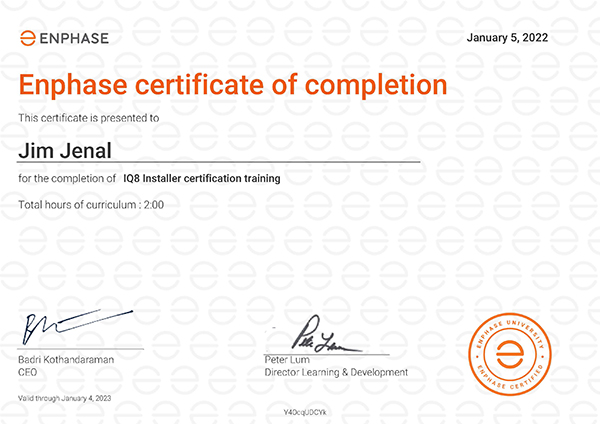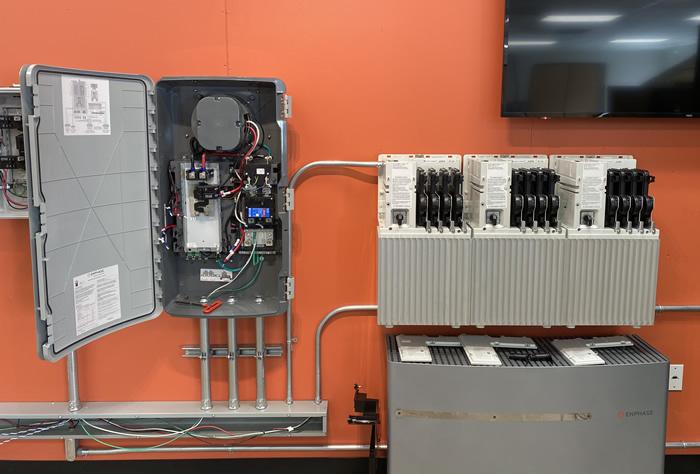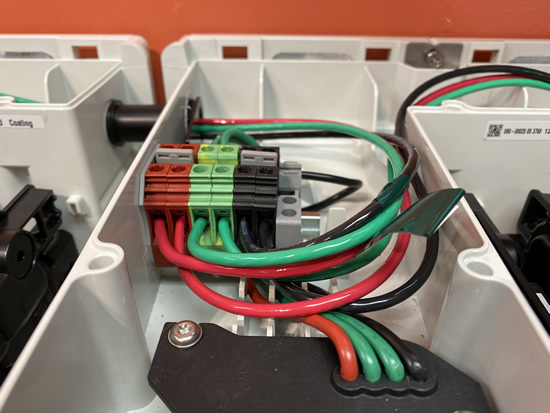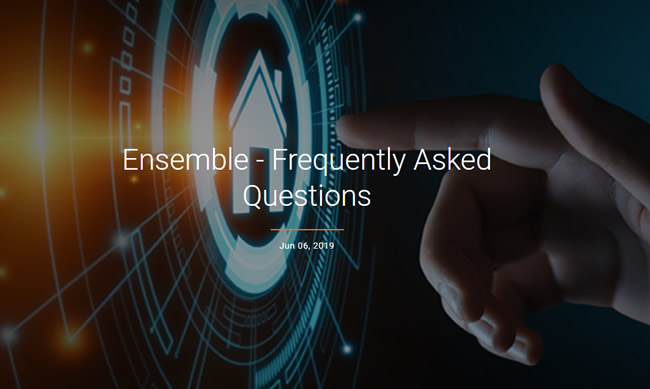Tag: "iq8"
01/05/22
Categories: All About Solar Power, Residential Solar
Guess Who is Certified to Install IQ8?
Readers of this blog know quite well that the long-awaited Enphase IQ8 microinverters are almost here. (Enphase reports that shipments have started, and our distributor is promising to have them in numbers by next month.) But there’s one slight catch: in order to commission a PV system with IQ8’s, you have to be certified by going through an online training at Enphase University!
So guess who just got certified?
The training takes you through all of the four use cases for installing IQ8: solar only (no backup or storage components), Sunlight Backup which allows partial backup even without adding any storage components, Partial Home Backup and Full Home Backup. Each of these use cases has different components, and those components need to be properly configured to guarantee that the solar system owner has the best possible experience.
We are excited to be at the forefront of this exciting next step in our partnership with Enphase, and with you, our cherished clients.
Let’s make 2022 one for the record books!
01/24/20
Categories: All About Solar Power, Residential Solar, Energy Storage
Hands-On with Ensemble - My Trip to Enphase!
I just returned from two days of hands-on training with the new Ensemble Storage System from Enphase Energy at their HQ in Fremont, California. Here’s my take…
Ok, to say that I have been somewhat obsessed over the Enphase IQ8 and its incarnation in the Ensemble Storage System over the last year and a half would be an understatement, having written about it here, here, here, here and here! I’ve attended webinars and conference sessions where Ensemble was discussed and the technology explained. But like any good installer, what I really wanted to do was get my hands on these devices, wire them up, and get a real feel for what it takes to put these on a client’s wall. This week I got my chance!
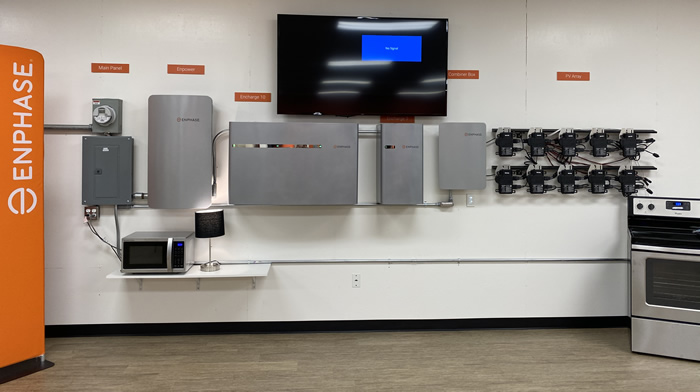
Ensemble Family Photo: Enpower, Encharge 10, Encharge 3, IQ Envoy Combiner.
(Click for larger image.)
Here is one view from the lab at Fremont. On the far left is a main service panel and meter. To its right is the Enpower Smart Switch which acts as a Microgrid Interconnect Device (or MID). Next is the Encharge 10, alongside its smaller sibling, the Encharge 3.
(As this image suggests, Encharge 10 and Encharge 3 can be combined as desired to achieve the combination of energy storage and power output required.)Next is the IQ Envoy Combiner (not new, although it now comes with a cellular modem standard).
Finally, there is the simulated array made up of IQ6’s and IQ7’s (both regular and Plus versions). Out of the field of the picture is a PV array simulator that powers the microinverters.
Oh, and no demo would be complete without some loads, including a light, a microwave, and an electric stove - all of which were powered by this system with the grid disconnected. (Some people have asked how fast was the switchover - so fast that the light doesn’t blink and the clock on the microwave did not reset.)
Over the course of the two days we spent a lot of time in the classroom - headed by Peter Lum, trainer extaordinaire - focusing on the nitty gritty. How do you size an Ensemble system, how do you mount these things, how do you wire them up, how do you comply with the electrical code?
Our lab time on the first day was a demo of the system on the wall. The second day, we were actually mounting these to the wall and wiring them up.
Getting Our Hands Dirty
I’ve already written a lot about the specs of these devices, so I won’t repeat that here. The point of this post is to discuss the actual installation process.
On the left is the Enpower with its deadfront removed, alongside the Encharge 10 with its cover removed. (The whitle, L-shaped pieces on top of the Encharge 10 cover are the screw down covers for the Encharge’s wiring compartment.)
Encharge 10
Let’s start with the Encharge 10 - as the photo makes clear, Encharge 10 is actually three Encharge 3’s mounted on a common mounting bracket. Each Encharge 3 includes four IQ8 microinverters, and they are individually replaceable, so should one ever fail, the others continue to operate and the monitoring will advise the installer of which unit has failed. All the field technician needs to do is remove the cover, disconnect the failed microinverter, plug in the replacement, and put the cover back on. Moreover, because the micros are on a common bus inside the Encharge 3, if one should happen to fail, you still have 75% of your total power, but 100% of your stored energy!
An Encharge 10 constitutes a 20 Amp branch circuit, and up to two Encharge 10’s can be wired together in series (maximum wire size is #8). If a larger storage system is required, then the Encharge units need to be landed in a dedicated subpanel. (The Enpower is rated for up to 80 Amps of storage.)
To the left of the IQ8s is the battery management unit and the battery disconnect switch. (Not really visible in this picture is a status LED that shows whether the battery is on or not, whether it is idle or charging, and the relative state of charge as it shifts from blue (discharged) to green (charged).
The finned area is the actual LFP batteries themselves. All cooling is passive, no fans are involved. The unit needs to be mounted a minimum of one foot from the ground, and if you have more than one row, at least six inches (vertically) between rows.
The mounting bracket is secured to the wall with sufficient hardware and into sufficient structure to support the total weight of 346 pounds. (Enphase will be releasing a white paper on best mounting practices - a must read to be sure!) Each individual Encharge 3 is then lifted onto the bracket. Given that these are over 100 pounds, this is a two-person lift to be sure! My colleague Greg and I struggled a bit with the lift, mostly because I wasn’t really pulling my weight - so to speak. (My value add isn’t really in lift strength!) But the younger guys that were in the training with us managed the task with ease - ah youth!
The Encharge 3’s are then daisy-chained together in a wiring compartment at the top of the units, as you can see in the picture on the left. Each terminal block can hold two wires, one coming in, one going out. The last unit just has the incoming connection and no other termination is required.
Note the black piece connecting to the two units. That is a plastic, snap in conduit section that is added after the units are mounted. The last unit in the chain has a rubber plug in that opening to keep the wiring compartment watertight.
(Note, the section with the microinverters is not watertight as the IQ8’s are NEMA 6x, which means that they can - and are tested to prove it - operate under water!)Once the wiring between the Encharge units is complete, the unit closest to the Enpower is then wired to it, and then the tops can be screwed on, and the cover added.
Enpower
Which brings us to the Enpower - which is both a MID and an interconnection center. Note, however, that Enpower is not a general purpose panelboard, but rather, a specially listed UL device and as such, the 120% rule does not apply. As a result, the Enpower will accommodate up to 80 Amps of PV input (i.e., a fully populated IQ Combiner) and 80 Amps of storage input (i.e., four Encharge 10’s.)
In the picture above, the input from the meter (if serving as a whole-home backup system) or the the main service panel (in a partial-home backup) comes in on the right hand side. In the picture there is an Eaton main service, bolt-down breaker installed. If this were intended for a partial-home backup with a breaker in the main service panel, the Eaton breaker could be omitted and the input conductors would land on the existing lugs.
Directly above that main breaker is the isolation relay, which trips when the grid fails and isolates the system for creating a microgrid. Above and to the center is the neutral forming transformer that allows the system to power 120 VAC loads. Below that on the left is the common bus that holds (going counterclockwise from the top left) the breaker for the PV, the breaker for Encharge, a breaker for a generator (but not yet), and the breaker for the neutral forming transformer.
You can see the conductors for all of those connections pre-wired in the photo, waiting to be attached to the appropriately sized breaker. The actual connections for both the PV and Encharge are made on lugs at the very bottom.
The output to the loads is at the base of the common bus where an appropriate Eaton breaker is added. Fun fact - the Eaton service rated breakers actually swap L1 and L2 from one side of the breaker to the other! This means that installers need to pay attention to their phasing so that the consumption and production CTs are reading the proper values - a topic we discussed in some detail in the classroom, and then verified in the lab - damn, isn’t hands-on training the best!
The Enpower switch, the Encharge units, and the IQ Envoy Combiner all communicate directly via Zigbee. In fact, each unit has two radios, one at 2.4 GHz and the other at 900 MHz and the units switch automatically between channels and frequencies as necessary to provide the clearest signal. Moreover, if the Combiner box is remote from the Enpower but closer to Encharge, the Encharge unit (or vice versa) can serve as a repeater to get signals to the other devices. Pretty clever.
Providing Feedback…
Of course, there are two purposes to a training like this during a beta period: to get the initial installers up to speed with the product, and for the installers to provide Enphase with feedback. Along the way we discovered a diagram that was wrong (nice pickup, Greg!), and a couple of places where esthetics got in the way of utility. Those are easy things to correct, and Enphase’s CEO himself came into our classroom to hear our feedback directly! That is a level of dedication to hearing what the long tail has to say that just isn’t happening with other solar companies.
Finally, a point of personal privilege: some years ago we did a video about our installation at Westridge School for Girls here in Pasadena (you can find it here.) Well what do you know but that video is part of a loop that is playing in the Enphase lobby! One of the engineers actually came up to me and exclaimed, “You’re the guy in the video!" Fun way to end our two days at Enphase HQ.
Bring on the Beta!
06/28/19
Categories: All About Solar Power, Residential Solar, Energy Storage
Ensemble Rollout Coming into Focus
On the heels of their video release last month, the folks at Enphase have now published an FAQ page on the entire Ensemble system. Here are some highlights…
Perhaps the most exciting item is that they are expecting deliveries around Christmas time – what a great gift! That said, I’m sure quantities are going to be limited at least initially. To that point, however, it looks like there will be a “pre-order” option - though the FAQ page is silent on details or pricing.
The most disappointing answer is that the system will not be compatible with S and M series microinverters, although they are planning an upgrade path, similar to the “Early Adopters” program that they had earlier this year.
Happy to hear your feedback - obviously we are following developments here closely, watch this space.
05/31/19
Categories: All About Solar Power, Residential Solar, Energy Storage
Enphase Releases Video on IQ8 and Ensemble
Our friends over at Enphase have posted a video to YouTube explaining in non-technical terms what the IQ8 will do for solar consumers, both in the developing world, and here at home. Here’s the video and some quick thoughts about it.
To quote the video, “Isn’t it cool?" Well yes, as we’ve been saying for quite some time here, this is waaaay cool. But here are some other takeaways from the video:
- Strong endorsement for interoperability with the IQ6’s and IQ7’s that we have been installing for the past year and a half. But no word about how this will work with earlier versions.
- The Enpower switch - which is needed to legally isolate you from the grid - is pictured, but still no details.
- A hint at pricing would be nice!
As far as I’m aware, this is the first, general-public-facing details about the IQ8 and Ensemble that Enphase has released. It went live on May 28, and three days later is sitting on just under 15,000 views, with 154 up-votes to 6 down-votes. (What is there to down vote? Gee, SEDG, troll much?)
This will be very cool technology for our clients, but it will truly be life-changing for folks in the developing world or any place where the grid is unreliable.
Watch this space.
11/07/18
Categories: All About Solar Power, Residential Solar, Solar Repairs
Enphase announces Upgrade Program for Early Adopters...
One of the nagging concerns in the solar industry is what to do about those aging legacy systems? As systems age there can be reliability issues and finding compatible parts can be a real issue in a fast moving technology environment like solar power. Given all of that, we are pleased to announce the Enphase Update Program for Enphase Early Adopters. There is a lot to this program, including three distinct upgrade paths, so let’s break it down step-by-step…
Who is Eligible?
This program is dedicated to the earliest adopters of Enphase microinverters, specifically the M175, D380, M190, and M210 models. (Of the eligible microinverter models, Run on Sun only ever installed the M210.) System owners that have M215’s, M250’s, or S280 microinverters are not eligible for this program.
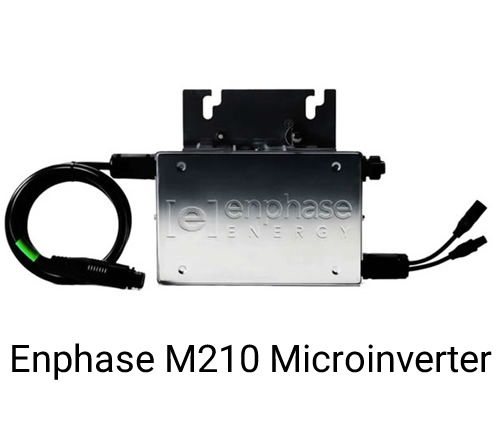 |
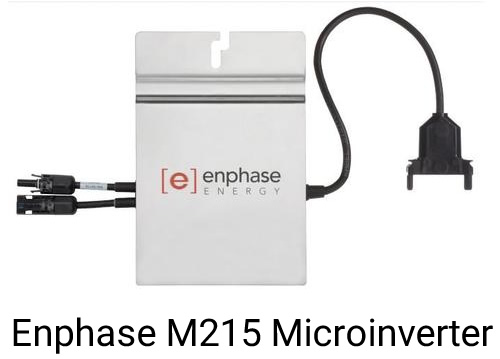 |
| The Enphase M210 qualifies for the upgrade… | While the subsequent generation M215 does not. |
What are My Options?
There are three upgrade paths with varying benefits, costs, and timing, however, all three offer full 25-year product warranties and a two year service agreement. The three options are: Microinverter Upgrade, Full-System Upgrade, and Next-Generation Upgrade - let’s take them one at a time.
Microinverter Upgrade
The most cost-effective option is the Microinverter Upgrade because it takes advantage of your existing solar panels that are likely still in good shape. This upgrade provides all of the following:
- New Enphase IQ7-PD - the latest generation microinverter, powered down to be compatible with existing, earlier generation systems.
- New interconnection cable
- New IQ Envoy with both production and consumption energy measuring devices* (CTs).
Legacy owners can purchase this equipment directly from Enphase for just $67.50/panel - a really great price. Removal and re-installation labor will vary widely based on various factors including the difficulty of the roof, the quality of the original installation, and whatever upgrades need to be done, probably on the order of $150/panel.
*Note that not all systems will be able to do consumption monitoring depending on the existing service panel configuration.
Full-System Upgrade
When microinverters like the M210 were being installed, available panel wattage was much lower than today, but with the advent of electric vehicles, homeowners are in need of more energy than ever. The Full-System Upgrade provides a way to gain from today’s higher power modules, but in a cost-effective manner.
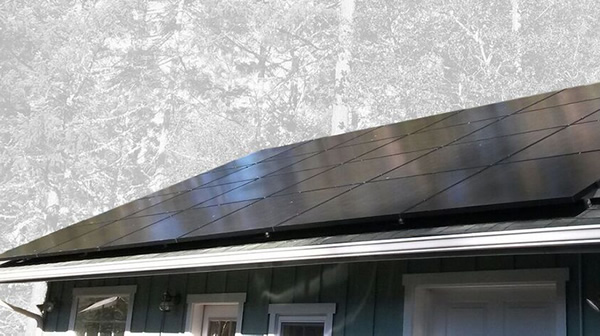
Enphase Energized Solaria PowerXT-AC Modules
This upgrade path involves the Enphase Energized Solaria PowerXT-AC Module, which has an Enphase IQ7+ microinverter integrated onto the Solaria module. (You can see an image of the Solaria modules on the left.)
The module has a power production of 295 Watts, substantially greater than what was available for legacy modules. The cost to the homeowner for this upgrade path is $469/panel, which includes the AC module, cabling, and the Envoy for monitoring.
Labor costs for this upgrade path are likely to be substantially higher, in part due to the need for new racking (the module dimensions are somewhat unusual - 63.8″ x 43.9″ - which could necessitate a racking change), changes in the sizing of the branch circuits, and the need to pull permits for the new system. Those factors are mitigated somewhat by the upgrade cost most likely qualifying for the federal 30% tax credit since it is an all new system, as opposed to the Microinverter Upgrade, that won’t.
Next-Generation Upgrade
Finally, the last upgrade option is to wait for the rollout of the Enphase IQ8 microinverter system. (You can read about what the IQ8 technology will provide here.) Unfortunately, there is no pricing information available yet for that upgrade path, and its availability is not until sometime in 2019 - probably the second quarter at the earliest.
What Happens if I do Nothing?
If your system is working fine, you don’t really have a need to do anything. However, these earlier microinverters came with a 15-year warranty, which means that more than half of that warranty period has expired. Moreover, particularly compared to the M190’s, the newest Enphase microinverters have significantly greater reliability (Enphase claims by an order of magnitude), so you would be upgrading to a more reliable product and extending your warranty protection by 25 years.
We will post again when we have more information regarding the Next-Generation, IQ8 upgrade. In the meantime, if you have questions about upgrading, please give us a call.
